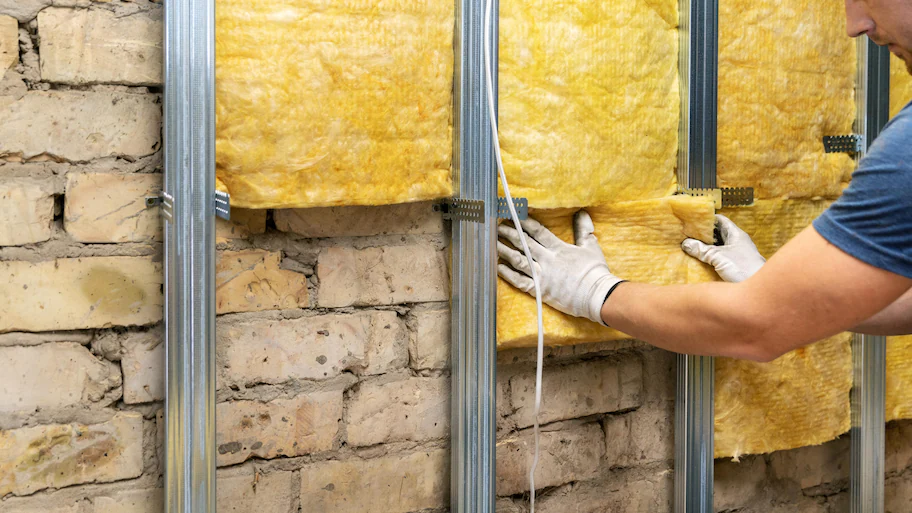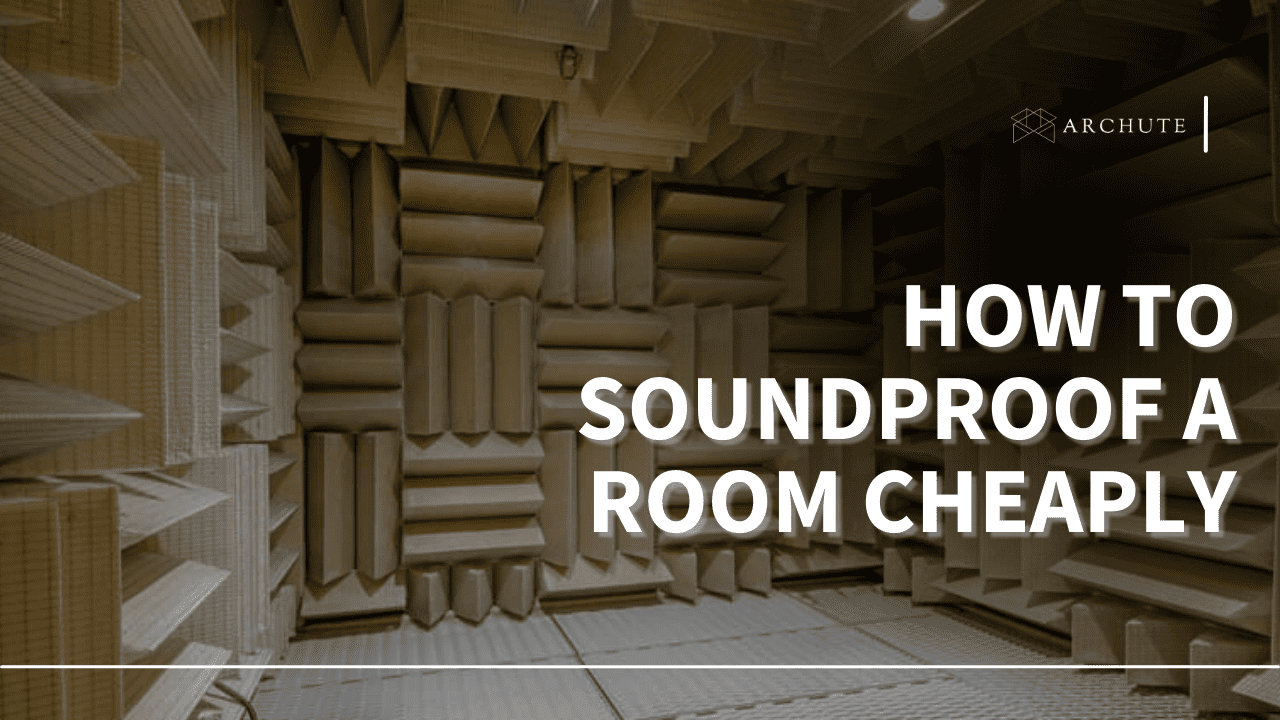Although noise is unavoidable in life, you can still find ways to control it. For example, hard surfaces usually cause soundwaves to bounce around the room through echoes and reverberation. Soundproofing insulation is part of the solution to creating a peaceful indoor space.
When soundproofing any area in your house, you should ensure proper insulation, as overlooking it will minimize the chances of great results. Soundproofing prevents noise from traveling from one room to another, one floor to another, and from exterior walls to the interior.
With many choices on the market, you might not know where to start and which one to choose, and we got you! Dive in!
What is Soundproofing Insulation? How Does It Work?

Image Credit: upgradedhome.com
Soundproofing insulation is an insulation type that blocks sounds coming in and out of the room. It is also a special type of insulation that offers acoustic benefits on top of heat insulation.
The best soundproofing insulation is used to deaden the sounds like construction or traffic, and insulation helps block sounds since it absorbs all sounds in the room.
Soundproofing insulation expands on the constant ability to transform energy, and like heat, sound travels through air until it contacts another surface. Then, the surface either reflects sound or absorbs it.
Since the insulation is a soft porous material that absorbs sound by converting it to heat where the heat disperses throughout the material before it reflects off the hard surface on the insulation's other side, the insulation is softer and thicker than regular insulation, improving the effectiveness against noise.
Rank | Product Image | Brand Name | Link |
|---|---|---|---|
1 | |||
2 | |||
3 | |||
4 | |||
5 | |||
6 | |||
7 |
1. Best Soundproof Insulation For Basement Ceiling

Image Credit: soundproofliving.com
Basement ceiling insulation helps with noise by absorbing the soundwaves and helping to prevent them from reaching your home's upper floors. How thick the insulation is will determine how much the insulation absorbs sound waves.
Your basement ceiling can be soundproofed with the correct type of insulation. For example, fiberglass insulation can absorb sound; heat can be kept within if applicable.
Johns Manville R19
- Item Weight: 24.0 lb
- Country of Origin: United States
- Brand name: JOHNS MANVILLE INTL
- Item Dimensions: 49.0"L x 19.5"W x 15.5"H
Johns Manville R19 is an excellent brand, and it measures 26 inches long by 19 inches wide by 23.5 inches high, weighing over 20 pounds, and you will get 75 square feet. The basement ceiling insulation is written on both sides, meaning you will need to ensure you finish your basement's ceiling if you need to use it.
However, be cautious of the fiberglass insulation is formaldehyde-free since we realized it can shed fiberglass dust. Therefore, we recommend it for basement ceilings where thermal insulation is not a concern. In addition, other reviewers say, if necessary, it can offer heat protection in your basement.

Archiexpo
Image Credit: archiexpo.com
The insulation is simple to install after you purchase it, and you may cut the roll to fit the area where you intend to use it. Even though it is nice and neutral since it is white, you should cover it with a finished ceiling.
We promise you will get a reasonable amount of insulation for the price, so you shouldn't need a lot of rolls. However, you must consider electrical elements to minimize potential fire sources.
Pros:
Cons:
2. Best Soundproofing Insulation for Exterior Walls

Image Credit: homeguides.com
The best soundproofing material to use on exterior walls is ECP foam installation. The ECP foam is used to construct soundproofing walls.
If your room is too hot during summer and winter, you can get some insulation on your room's exterior walls. They are heat resistant and can easily maintain your room's temperature.
Foam panels are suitable for the exterior walls of a room where they provide soundproofing properties within a room. If you want an extra layer of soundproofing in your home, you should try adding foam panels.
Luxhive Acoustic Foam Panels
- Acoustic Flat Panel 1" x 24" x 48" Good Quality Foams! Color:...
Acoustic flat panel is a good quality foam that we recommend for great soundproofing over large areas. The thin foam has less chance of distorted and muffled sounds over a large area. Thanks to a uniform design, it will help you trap airborne noise and alleviate flutter echoes.
The acoustic panels are suitable for spot treatment in home entertainment centers, production studios, and practice rooms. The foam also helps with echo complications and eliminates flutter and sound waves.

Image Credit: soundproofliving.com
The foam panels don't fall apart over time or deteriorate, and all you will need to do is dust them over time. We recommend it most when you are not interested in full sound deadening, which is unnecessary if you want moderate deadening.
Other reviewers also stated that the acoustic panels are designed with an open cell and provide a powerful noise reduction, making them perfect for control rooms, recording studios, and vocal booths.
Pros:
Cons:
3. Best Soundproofing Insulation for Ceiling

Image Credit: familyhandyman.com
Ceilings make structure-borne noise because of the footsteps or heavy machines of the person living in the above apartment. To better the insulation of a ceiling, you can use cellulose as a DIY solution for sound insulation ceilings.
Although many soundproof insulation materials can be used for ceilings in the market, the best choice is fiberglass insulation. One reason it works is that it's too thick, which is why sound doesn't pass easily into it. Instead, the fiberglass insulation absorbs all sounds and maintains the echoes in a room.
HEWEIYHY 50 Pack Acoustic Panels Soundproof Studio Foam
- u【Eco-friendly and Safety】Made of high quality...
- u【Noise Absorbing】Our sound foam panels can dampen and...
- These soundproofing foam panels come with 24 pack in the package,...
- u【Easy to Install】These studio sound absorbing panels can be...
- u【Widely Usage】Our sound dampening foam panels are great for...
HEWEIYHY 50 Pack Acoustic Panels are high-quality, environmentally friendly polyurethane foam panels that are effective and durable with no health risks. We vouch for them if you want to reduce interference and improve sound clarity. The sound foam panels can disperse and dampen mid-to low-frequency sound waves inside a space.

Image Credit: ubuy.dk
With just a few staples, nails, screws, tacks, or glue, you may use these studio sound absorption panels to cover walls, ceilings, and doors to reduce noise. Lastly, these sound-dampening foam panels are perfect for concert halls, home theaters, professional movie theaters, recording studios, vocal booths, control rooms, and more.
Pros:
Cons:
4. Best Soundproofing Insulation for Windows

Image Credit: houselogic.com
Windows are a major area that might contribute to leakage around fixing the window and its frame. If no space remains to pass the air, then no air will pass.
To increase the sound insulation of windows, you should focus on soundproofing the windows that cover the use of different materials. For example, you can use a soundproof curtain to help absorb unwanted noise passing through the window and minimize transmission energy while reducing echoes.
Also, the window might need some weatherstripping to fill air gaps between the glass and the window frame, and you might boost the insulation with double glazing of the existing window.
Nicetown Microfiber Noise-reducing Thermal Insulated Curtain
- READY MADE: Set includes 2 BLACKOUT PANELS of 42" wide x 84"...
- SERVE WELL: Curtains impede 85%-99% light and UV rays(Dark color...
- ENERGY SMART: Triple weave blackout fabric balances room...
- GOOD TO GO: Thread trimmed and wrinkle-free, ring (1.6-inch inner...
- EASY TO MAINTAIN: NICETOWN blackout curtains are made to last....
Nicetown insulated curtain set has insulating microfibers that provide insulation while they block out light. Each panel has a black yarn between two microfiber layers to provide insulation against the summer heat and winter cold.
The thermal insulated curtain blocks up to 99% sunlight while reducing noise. They come in a machine-washable fabric, making them easy to clean, but it can take some time before you get rid of the wrinkles.

Image Credit: rollingstone.com
When we tested, we found that its triple layer design effectively hid the inner black thread layer. However, we also discovered that the manufacturer's 99% light blocking claim was somehow an exaggeration.
While they were effective at filtering out light and heat, we'd estimate that the proportion was more like 75% to 80% than 99%. They reduced some noise as well.
Pros:
Cons:
5. Best Soundproofing Insulation for Doors

Image Credit: homestratosphere.com
The door is a major area in a room after the wall covering a large space because of the weak door, which could be a weak insulation source. To increase sound insulation on a door, use a soundproof blanket or a door curtain, which are both effective and could qualify as temporary solutions if you need some time.
Foam It Green 602 Spray Foam Insulation
- Quickly Seals Out Air & Insulates
- 17 Free Extras with Orders Over $250
- Light Green Foam Reduces Waste
- Appr. 602 square feet at 1 inch thick of cured foam
- 24/7 Customer Support
This Foam It 602 spray foam insulation is a kit that seals and insulates doors or any area within seconds. We noticed the spray foam has a pressurized application canister to deliver foam. You will also get ten nozzles, isocyanate-resistant gloves, a 15-foot hose with an application gun, and a Tyvek suit.
This product gives you everything you will need to apply the product safely and correctly, which results in a foam classified as a Class I E-84 fire retardant. In addition, it is antimicrobial, meaning you won't have to worry about mold growth when you close up the surface you are insulating.

Image Credit: vanlifeprep.com
However, if you need to fill doors or existing hollow walls, we advise you to avoid this product. If you need to do this, opt for a slow-rise formula.
Pros:
Cons:
6. Best Soundproofing Insulation for Interior Walls

Image Credit: ecohome.com
When working on soundproofing walls, you need to use the best soundproofing insulation installed, and many types of insulation are on the market. For example, mineral wool insulation and Owens Corning are perfect for efficiently reducing noise.
The insulation is perfect for making a house or room soundproof, and you can easily install the insulation in the room.
Owens Corning R-19 Faced Fiberglass Roll
- Individual Faced Roll - 15 Inches Wide x 39.2 Feet Long x 6.25...
- Ideal for use in attics and floors; providing excellent thermal...
- With less dust than other fiberglass products, EcoTouch PINK...
- Compression packaging from Owens Corning speeds job site handling...
- GREENGUARD GOLD Certified and validated to be Formaldehyde free
If you need fiberglass insulation with the best health ratings, you can never miss this Owens Corning Pink insulation. Owens Corning R-19 is made with advanced fiber technology, safe ingredients, and no dust, and it also improves the air quality of a room.
Owens Corning is one of our top choices because it's easy yet has a fast installation process, where each batt cuts easily and recovers instantly. Also, after you shape the insulation, you won't remain with a huge mess, and with less dust, there won't be much to clean up.
The fiberglass insulation is heat, moisture, and sound resistant, so you can install the pink installation on the interior walls and ceilings to absorb all unwanted noise and other elements.

Image Credit: homedepot.com
Owens Corning R-19 is also on our list because you won't have to worry about harmful ingredients when installing it. The formula is safe and proven with healthy ingredients for you and your home.
In addition, the wall insulation is GREENGUARD Gold certified, meaning the soundproofing material contributes to a better internal quality.
Lastly, we noticed the fiberglass insulation has an STC rating of about 36, this guarantees your interior walls and ceilings are fully soundproofed against loud sounds.
Pros:
Cons:
7. Best Soundproofing Insulation Between Floors

Image Credit: Pricewiseinsulation.com
The best insulation product that works between floors is acoustic foam, which reduces sounds between beds. When you are installing insulation between floors, it works as a barrier to prevent your room from becoming noisy.
In addition, using acoustic insulation between your floors helps to block out all the air activities that may contribute to sound traveling to the room.
Rockwool Acoustic Mineral Wool Insulation
- Mineral Wool Insulation in 6 pounds per unit density.
- Great as Acoustic insulation or as a soundproofing material
- Cost effective and Very High NRC Rating, better than Owens...
- Water repelling - hydrophobic- Class A fire rating
- Rigid Boards, perfect for making acoustic panels and bass traps
Rockwool, a batt insulation product, comes in 48 by 24-inch panels regardless of your density. We recommend this product since its size is suitable for filling spaces between floor joists and wall studs. Alternatively, it can be used to make acoustic panels and bass traps.
Rockwool has a noise reduction coefficient of 0.8, which means it will stop about 80% of airborne and impact noise. It is better at absorbing high frequencies than the low ones, and the NRC score drops to 0.07 in the 125Hz range.

Image Credit: elagazas.hu
Rockwool 40 features a density of 4 and 6 pounds for each unit. Lastly, besides being a great soundproofing product, this Rockwool insulation is hydrophobic and a class A fire resistance material.
Therefore, we recommend it as the best product if you are more interested in acoustic features than soundproofing.
Pros:
Cons:
What Types of Noise Can Soundproofing Insulation Help?

Image Credit: soundprooofing.com
Before choosing soundproofing insulation, you must check what it can or can't do. There are several ways sound can be a disturbance where sound transmission is used to describe the ability of a soundwave to pass in or out of a room through a solid surface like a ceiling, walls, or floor.
On the other hand, sound reflection is when a soundwave bounces off a hard surface and reverberates or echoes within a room. Reflection and transmission need separate solutions where soundproofing will prevent transmission and sound absorption will prevent reflections.
Soundproofing insulation comes with absorbent properties making it a perfect solution for reflections.
What are the Main Types of Soundproof Insulation?

Image Credit: homestratosphere.com
Insulation types usually break down the big categories, and most people tend to gravitate toward one specific one. Below are all the major types of soundproof insulation:
1. Batt Insulation
Batt insulation is blanket insulation that comes in rolls, and this product is as wide as the space between wooden studs in your walls, ceiling beams, and floor joists, whether you get rolls or insulation panels. The insulation is between an inch and several inches thick, so you should find the ones that fit inside your walls, no matter how thin they might be.

Image Credit: osb.westfraser.com
Batt insulation is rectangular, meaning you can install it without customizing it, but if you cut certain parts, the base of the material might be a factor. Furthermore, the base material affects how insulation performs its main job of soundproofing and thermally insulating the ceiling or wall you put in.
The materials that make up the Batt insulation include fiberglass, cotton and mineral wool, and many more. When users hear about batt insulation, soundproofing might not be the first thing on their mind, but it's versatile insulation that can help with multiple things at a go.
2. Foam Spray Insulation

Image Credit: buildingenergyvt.com
Some users believe this is the future since it's very easy to work with, and some out it inside brick cavities without taking them apart. At the start, the insulation is in liquid form, and the polyurethane can get into a cavity by using a small hole where it starts to form the space, and the process moves quickly.
Once the cavities are filled, they easily close off and go from there, which is a straightforward, expensive process.
3. Blown Insulation

Image Credit: bobvilla.com
Blown insulation doesn't work the best from a soundproofing perspective, and the only time it might be necessary is if the room you need to soundproof is the attic.
This is the only place this type of insulation is used anymore and is uniquely distributed. The material combines fiberglass and cellulose and is blown in chunks to fill space.
4. Insulation Boards or Panels

Image Credit: cannonplastec.com
Insulation boards are types of thermal boards that have varying R-values and thicknesses. The polyutherane foam board insulation is a perfect soundproofing material to use within walls. It is an excellent alternative to standard fiberglass batt insulation thanks to its higher R-value per inch.
Foam board insulation has three different types:
- EPS or expanded polystyrene has an R-value of 4 per inch, and this material type helps to protect fragile things in transit.
- Extruded polystyrene- It is dense and has a high notch R-value per inch
- Polyiso is the most expensive type but the most effective, with a high R-value of 6 per inch. It is the ideal underlayment sheathing to use in attics.
Benefits of Soundproof Insulation

Image Credit: sansums.com
One of the biggest advantages of soundproofing insulation is absorbing energy and making it among the most versatile products for your business or home. Also, apart from stopping reflections, property owners use it for other reasons such as:
1. Energy Efficient
While noise reduction is the main selling point, acoustic insulation is also good for trapping heat to maintain coolness in buildings in the summer and warm during the winter. This means as much as your ears will thank you; your wallet will be thankful too!
2. Easy to Install
Although some soundproofing solutions are labor intensive, soundproofing insulation is easy to fix or slide into ceilings or within walls.
3. Environmentally friendly
Most soundproofing insulation materials are recycled or created as a byproduct of a manufacturing process.
What Are the Best Soundproof Insulation Materials?
Manufacturers use different materials to give soundproofing insulation even though the premises before noise reflects into a room stays the same. There are three main types of acoustic insulation types, and they include:
1. Mineral Wool Insulation

Image Credit: buildwithrise.com
Mineral wool insulation is an inorganic fiber-based insulation material that mostly comes from natural stone fibers from volcanic rock or spinning slag, a byproduct of steel production. When scouting for mineral wool, you will find two grades: multipurpose and high performance.
Multipurpose mineral wool insulation is affordable with an NRC that maxes out at about 0.8 to 0.9, and high-performance mineral wool insulation is more expensive with an NRC of between 0.95 and 1.05.
2. Fiberglass Insulation

Image Credit: atticconstruction.com
Fiberglass insulation is a material made of extremely fine glass formed in rolls or batts, which serves the exact purpose of insulating energy within a home. The R-value will depend on how large and thick it is applied to the floors, attics, walls, and ceilings.
It has an R-value of 2.2 to 2.7 inches, and since it works well with heat energy, it will also work on sound absorption. Also, another type of fiberglass insulation comes in loose fills, which are blown on the area when installation.
3. Cotton
Cotton insulation is the lightest and cheapest option but still offers high sound absorption capabilities. In addition, it is safer for sensitive skin than mineral wool or fiberglass insulation.
Cotton offers an ability to absorb the high frequencies with light, fluffy cotton fibers that are fairly dense and multi-dimensional. Unfortunately, this means there is a lot of material to trap sound from different angles.
Lastly, a two-inch cotton insulation panel has an NRC rating as high as 1.0.
Why Is Insulation Important for Soundproofing?

Image Credit: aquietrefuge.com
Soundproofing works well when you are interested in isolating noise. The two types of noise to lock in are airborne and impact noise. Impacted noise is achieved through a direct impact, but it needs an object to travel to its recipient comfortably.
Examples of airborne noise are animal sounds, road noise, people's conversations, and neighbors shouting or revving cars. On the other hand, examples of impacted noise are vibrating, footsteps, door banging, rattling, humming sounds from appliances, and musical instruments playing, among others.
In addition, to control the sound transmission from one source to another, the material is needed to cover the sound and absorb vibration to ensure when it gets to your ears, it is less irritating.
Is There a Difference Between Soundproofing & Sound Absorption?

Image Credit: soundproofcentral.com
Sound absorption and soundproofing are two different methods where the proof in soundproofing can mean the resistance against sound. It simply explains blocking sound waves moving from one source to another.
Sound absorption is the process of applying using materials to soak the sound by lessening the vibration and echo effect in the space. Notably, the materials need to be soft for them to absorb sound.
Some examples are acoustic curtains, acoustic panels, acoustic blankets, acoustic baffles, and any material with a soft cushion.
However, soundproofing materials are dense, solid, and heavy, heaving the characteristic of reflecting or blocking sound and preventing it from traveling to another space.
Factors to Consider Before Purchasing the Best Soundproof Insulation
After a general understanding of the most popular soundproofing materials, several more factors are to consider. Effectiveness, ease of installation, price, and other aspects that might not be immediately obvious must all be balanced. Some essential things to consider are:
1. Performance
When it comes to soundproofing effects, it can sometimes feel relative where changes like installing acoustic panels or hanging curtains may have a major difference immediately. However, it might feel less effective with time as the user is getting used to change, and for this reason, there is a rating system that helps offer the right answers to how effective a soundproofing material is.
Sound Transmission Class (or STC) is a good isolation rating described in numbers, and it determines how well a material blocks noise and sounds. Generally, the higher the numbers, the better.
Noise Reduction Coefficient (NRC) describes how a product absorbs sounds ranging from 0 to 1, with 1 being the most effective. NRC ratings are very effective for using a product for determining how effective a product like a curtain or a panel is.
2. Installation Process
Installation should be a key factor when choosing the strategy or type of soundproofing materials. Curtains and acoustic panels might be as far as someone who isn't very handy feels comfortable going. However, if you're a DIY pro, you could find that tearing down some drywall and adding soundproof insulation is the best option.
Generally, curtains and acoustic panels are the simplest soundproofing materials to install. Soundproof paint would probably come next, although its usefulness might not be achieved without other soundproofing techniques.
Finally, wall insulation and underlayment are more difficult but worthwhile if a project is already underway.
3. Cost
Several factors affect how much each type of soundproofing material costs. Probably the most significant aspect is the size of the area that needs to be soundproofed. Design and aesthetics can also increase costs; if renovations are required, the cost may skyrocket.
When choosing a budget for soundproofing, it's essential to weigh what you need against what is desired. For example, you will need a large budget if you need a music studio or a podcast. However, a small budget should do the trick for someone who needs to sleep better or block sounds from a neighbor's barking dog.
4. Noise Reduction Coefficient (NRC)
When looking for effective soundproofing insulation, evaluating a product's noise reduction coefficient (NRC) can help determine whether the cost is worth it.
Noise Reduction Coefficient (NRC) is the amount of sound material will absorb per square foot or on a scale of 0.0-1.0 as a percentage. An NRC of 0.0 stands for complete reflection with no absorption, whereas an NRC of 1.0 is complete absorption without no reflection.
An NRC rating of.90 indicates 90% absorption. NRC can sometimes exceed 1.0 since new, more potent absorbent materials have been found. Lastly, since the true function of soundproofing insulation is absorbing sound, you should choose a material with an NRC close to 1.0.
5. Additional Features
The best soundproofing materials usually have features that help to serve additional purposes where some might have added conveniences. For example, others might make a difference in the user's bank account.
a). Insulation
Some soundproofing materials are insulators, which minimize the need for intense heating or cooling. Mineral wool insulation can significantly reduce utility costs, especially in older homes without insulation.
b). Moisture Control
In some situations, underlayment for floors stops the floor from absorbing moisture in addition to blocking sounds.
c). Fire Resistance
In addition to being soundproof and insulating, mineral wool is fire resistant. Some companies provide soundproofing materials that can resist temperatures of more than a thousand degrees Celsius.
d). Light Control
Certain materials, such as acoustic panels and curtains can aid in light control. The soft fabric faces of acoustic panels can prevent light from bouncing around the room, while curtains can block light from entering the space.
Conclusion
When it comes to soundproof insulation, choosing the right product for your needs can be overwhelming, mainly if you want to soundproof your home or improve your acoustics. Generally, mineral wool insulation is the best for soundproofing needs, cellulose is the best for acoustic treatment, and fiberglass insulation is a good option.
Frequently Asked Questions
1. Can you Soundproof Existing walls with Insulation?
Although the main wall insulation focus is thermal control, you can reinforce insulations by ensuring no gaps or weak points can form air pockets. This minimizes the chance of opening a passage of sound waves or a chance of moisture.
You can use cellulose spray foam to fill the existing wall holes or gaps to act as a soundproofing barrier. Notably, you should supply and install all the openings when installing insulation in the existing wall.
2. Which is Better Between Foam Insulation and Fiberglass Insulation?
When the installation process is done poorly, fiberglass insulation can leave spaces and gaps, allowing sound and air to escape. In contrast, the foam spray insulation doesn't leave a chance for crevices, fissures, and small cracks, allowing air pockets to form.
This envelops the internal barrier structure with the cavity walls such as electrical receptacles, pipes, and wires.
Image Credit: angi.com





















